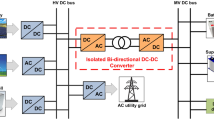Abstract
In electric vehicles (EVs), the major role of BLDC motor is controlling the speed of a vehicle and effective breaking. This can be achieved by reducing the torque and managing the current flow in the motor. In recent researches, current-controlling methods in BLDC give the better way in controlling the speed of a motor. This research work focuses on the design of the speed control system. In this, EV is run by the battery connected with the photovoltaic (PV) system. The proposed work optimally controls the switching devices to manage power for BLDC motor. This extracts the properties of PV system with feedback signals of the bidirectional converter and motor terminals to evaluate the energy transfer level to EV. This can also reduce the decaying effect of battery, which is connected parallel to the converter. Since the proposed controller truncates the error signal with varying angle of vector quadrant named as Truncated Angle Variant (TAV) controller, this can also monitor the accelerator frequency that refers to the required speed of the BLDC motor. The experimental result shows the performance of proposed TAV-based controlling technique and the comparison of parameters with state-of-the-art methods is also made.
Graphic abstract





















Similar content being viewed by others
Abbreviations
- EV:
-
Electric-Vehicle
- PV:
-
PhotoVoltaic
- TAV:
-
Truncated Angle Variant
- PHEV:
-
Plug-in Hybrid Electric Vehicle
- PWM:
-
Pulse Width Modulation
- SVPWM:
-
Space Vector PWM
- RE:
-
Renewable Energy
- BLDC:
-
BrushLess DC Motor
- PSO:
-
Particle Swarm Optimization
- BF:
-
Bacterial Foraging
- SRM:
-
Switched Reluctance Motor
- FCS–MPC:
-
Finite Control Set Model Predictive Control
- RSAM:
-
Response Surface Approximate Model
- RBF:
-
Radial Basis Function
- SoC:
-
State of Charge
- PFC:
-
Power Factor Corrector
- DTC:
-
Direct Torque Control
- MPTC:
-
Model Predictive Torque Control
- PID:
-
Proportional Integral and Derivative
- ANFIS:
-
Adaptive neuro-fuzzy inference system
- I-AMT:
-
Inverse automated manual transmission
- DICM:
-
Discontinuous Inductor Current Mode
- FPGA:
-
Field Programmable Gate Array
- FOFPD:
-
Fractional Order Fuzzy PD
- FOFPI:
-
Fractional Order Fuzzy PI
- ZNM:
-
Ziegler–Nichols step response method CCM Cohen-Coon method
- CHRM:
-
Chien–Hrones–Reswick method
- AIOFBL:
-
Adaptive Input–Output Feedback Linearization
- PDC:
-
Phase Delay Compensator
- PAAC:
-
Phase Advance Angle Control
- MPP:
-
Maximum Peak Point
- KVL:
-
Kirchhoff’s Voltage Law
- PLL:
-
Phase Locked Loop
- THD:
-
Total Harmonic Distortion
- FFT:
-
Fast Fourier Transform
- \( C_{v} \) :
-
Voltage constant from the PV characteristics
- \( C_{i} \) :
-
Current constant from the PV characteristics
- \( X^{T} \) :
-
State vector of system at ‘T’ time instance
- \( M_{T} \) :
-
Coefficient value of components in Hamiltonian Function
- \( I_{\text{S}} \) :
-
Stator current
- \( I_{\text{r}} \) :
-
Ripple current
- \( \omega \) :
-
Angular velocity
- \( I_{\text{c}} \) :
-
Capacitor current
- \( Y_{{{\text{p}} - {\text{i}}}} \) :
-
Proportional and integral of the error signal
- f :
-
Frequency
- \( V_{\text{out}} \) :
-
Output voltage at DC–DC Converter
- \( V_{\text{in}} \) :
-
Input voltage at DC–DC Converter
- \( D \) :
-
Duty cycle of controlling signal
- V m :
-
Output voltage from inverter
- V T :
-
Desired terminal voltage in inverter
- K T :
-
Gain value of the inverter control
- T(S):
-
Transfer function of error signal in converter design
- G(S):
-
Transfer function of error signal in inverter design
References
Dudley B (2018) BP statistical review of world energy. BP Statistical Review, London, UK
Sun X et al (2016) Internal model control for a bearingless permanent magnet synchronous motor based on inverse system method. IEEE Trans Energy Convers 31(4):1539–1548
Ramya A, Imthiaz A, Balaji M (2016) Hybrid self tuned fuzzy PID controller for speed control of brushless DC motor. Automatika 57:672–679
Sun X et al (2019) State feedback control for a PM hub motor based on gray wolf optimization algorithm. IEEE Trans Power Electron 35(1):1136–1146
Zaky MS (2015) A self-tuning PI controller for the speed control of electrical motor drives. Electr Power Syst Res 119:293–303
Fahem K, Charies DE, Sbita L (2018) Performance evaluation of continuous and discontinuous pulse width modulation techniques for grid–connected PWM converter. Int Trans Electr Energy Syst 28:1–14
Dordevic O, Levi E, Jones M (2013) A vector space decomposition based space vector PWM algorithm for a three-level seven-phase voltage source inverter. IEEE Trans Power Electron 28:637–649
Hadley SW, Tsvetkova AA (2009) Potential impacts of plug-in hybrid electric vehicles on regional power generation. The Electr J 22:56–68
Tie SF, Tan CW (2013) A review of energy sources and energy management system in electric vehicles. Renew Sustain Energy Rev 20:82–102
Erdinc O (2014) Economic impacts of small-scale own generating and storage units, and electric vehicles under different demand response strategies for smart households. Appl Energy 126:142–150
Pati AK, Sahoo NC (2019) A novel power quality enhancements scheme for three-phase differential boost inverter based grid-connected photovoltaic system with repetitive and feed backlinearizing control. Int Trans Electr Energy Syst 29:1–25
Azizi Idris, Radjeai Hammoud (2018) A new strategy for battery and supercapacitor energy management for an urban electric vehicle. Electr Eng 100(2):667–676
Kanna GRR et al (2019) A novel hybrid DC–DC converter with high voltage gain for electric vehicle charging systems. J Electr Eng 19:1–6
Song Z et al (2015) Optimization for a hybrid energy storage system in electric vehicles using dynamic programing approach. Appl Energy 139:151–162
Varesi K, Radan A, Hosseini SH, Sabahi M (2015) A simple technique for optimal selection of degree of hybridization (DOH) in parallel passenger hybrid cars. Automatika 56:33–41
Kofinas P, Dounis AI, Papadakis G, Assimakopoulos M (2015) An Intelligent MPPT controller based on direct neural control for partially shaded PV system. Energy Build 90:51–64
Oshaba AS, Ali E, Elazim SA (2015) MPPT control design of PV system supplied SRM using BAT search algorithm. Sustain Energy Grids Netw 2:51–60
Sun F, Xiong R, He H (2016) A systematic state-of-charge estimation framework for multi-cell battery pack in electric vehicles using bias correction technique. Appl Energy 162:1399–1409
Liu Y, Zhao J, Xia M, Luo H (2014) Model reference adaptive control-based speed control of brushless DC motors with low-resolution Hall-effect sensors. IEEE Trans Power Electron 29:1514–1522
Niapour SKM, Tabarraie M, Feyzi M (2014) A new robust speed-sensorless control strategy for high-performance brushless DC motor drives with reduced torque ripple. Control Eng Pract 24:42–54
Premkumar K, Manikandan B (2014) Adaptive neuro-fuzzy inference system based speed controller for brushless DC motor. Neurocomputing 138:260–270
Bist V, Singh B (2014) An adjustable-speed PFC bridgeless buck–boost converter-fed BLDC motor drive. IEEE Trans Ind Electron 61:2665–2677
Baszynski M, Pirog S (2014) A novel speed measurement method for a high-speed BLDC motor based on the signals from the rotor position sensor. IEEE Trans Industr Inf 10:84–91
Gao B, Liang Q, Xiang Y, Guo L, Chen H (2015) Gear ratio optimization and shift control of 2-speed I-AMT in electric vehicle. Mech Syst Signal Process 50:615–631
Wu X, He X, Yu G, Harmandayan A, Wang Y (2015) Energy-optimal speed control for electric vehicles on signalized arterials. IEEE Trans Intell Transp Syst 16:2786–2796
Sun X et al (2019) MPTC for PMSMs of EVs with multi-motor driven system considering optimal energy allocation. IEEE Trans Magn 55(7):1–6
Premkumar K, Manikandan B (2015) Speed control of brushless DC motor using bat algorithm optimized adaptive neuro-fuzzy inference system. Appl Soft Comput 32:403–419
El-Samahy Adel A, Shamseldin Mohamed A (2018) Brushless DC motor tracking control using self-tuning fuzzy PID control and model reference adaptive control. Ain Shams Eng J 9(3):341–352
Sabir M Kassas (2015) A novel and simple hybrid fuzzy/PI controller for brushless DC motor drives. Automatika 56:424–435
Sun X et al (2019) Speed sensorless control for permanent magnet synchronous motors based on finite position set. IEEE Trans Ind Electron 67:6089–6100
Kanna GRR, Muthulakshmi K, Vinitha SR, Raja RMS (2019) Design & implementation of single switch DC–DC resonant converter for hybrid vehicle. In: 2019 Third international conference on inventive systems and control (ICISC), pp. 336–341. IEEE
Zhang Qiao, Li Gang (2019) A predictive energy management system for hybrid energy storage systems in electric vehicles. Electr Eng 101(3):759–770
Kumar V, Rana K, Mishra P (2016) Robust speed control of hybrid electric vehicle using fractional order fuzzy PD and PI controllers in cascade control loop. J Franklin Inst 353:1713–1741
Chen S, Liu G, Zhu L (2017) Sensorless control strategy of a 315 kW high-speed BLDC motor based on a speed-independent flux linkage function. IEEE Trans Ind Electron 64:8607–8617
He X, Cui T, Zhang D, Wei J, Wang M, Yu Y et al (2017) Development of an electric-driven control system for a precision planter based on a closed-loop PID algorithm. Comput Electron Agric 136:184–192
Boroujeni MS, Markadeh GA, Soltani J (2017) Torque ripple reduction of brushless DC motor based on adaptive input-output feedback linearization. ISA Trans 70:502–511
Lee M, Kong K (2018) Fourier-Series-Based Phase Delay Compensation of Brushless DC Motor Systems. IEEE Trans Power Electron 33:525–534
Mohamed A, Berzoy A, Mohammed OA (2017) Design and hardware implementation of FL-MPPT control of PV systems based on GA and Small-Signal analysis. IEEE Trans Sustain Energy 8:279–290
Rajeshkannan GR, Thiagarajan S (2015) A single-phase grid-connected PV cell system based on a boost-inverter. Int J Adv Res Electr Electron Instrum Eng 4:2320–3765
Jiang W, Huang H, Wang J, Gao Y, Wang L (2017) Commutation analysis of brushless DC motor and reducing commutation torque ripple in the two-phase stationary frame. IEEE Trans Power Electron 32:4675–4682
Singh Praveen Kumar (2018) BLDC motor drive based on bridgeless landsman PFC converter with single sensor and reduced stress on power devices. IEEE Trans Ind Appl 54(1):625–635
Author information
Authors and Affiliations
Corresponding author
Additional information
Publisher's Note
Springer Nature remains neutral with regard to jurisdictional claims in published maps and institutional affiliations.
Rights and permissions
About this article
Cite this article
Rajesh Kanna, G.R., Sasiraja, R.M. & Prince Winston, D. Design and development of Truncated Angle Variant (TAV) controller for multi-source-fed BLDC motor drive. Electr Eng 102, 1931–1946 (2020). https://doi.org/10.1007/s00202-020-01004-8
Received:
Accepted:
Published:
Issue Date:
DOI: https://doi.org/10.1007/s00202-020-01004-8




